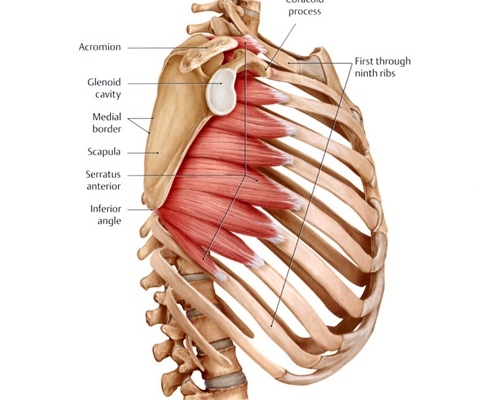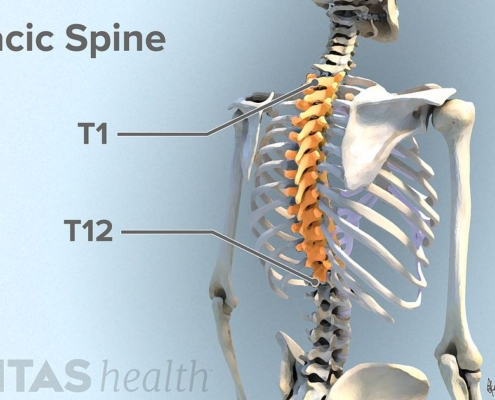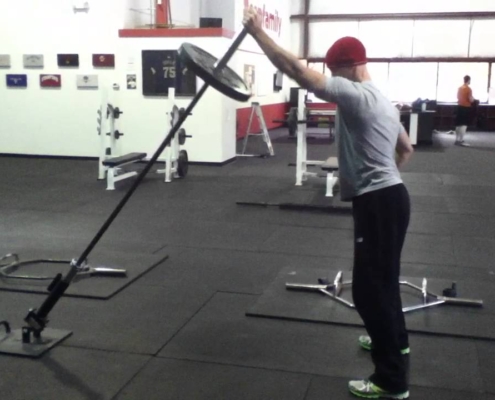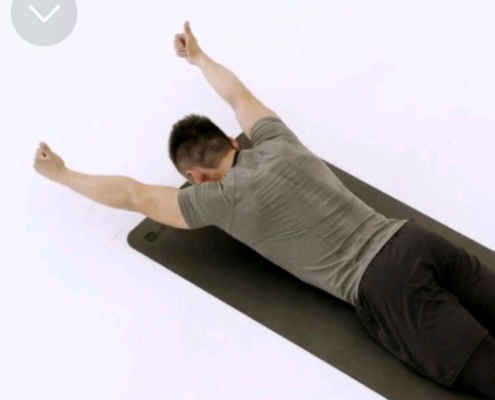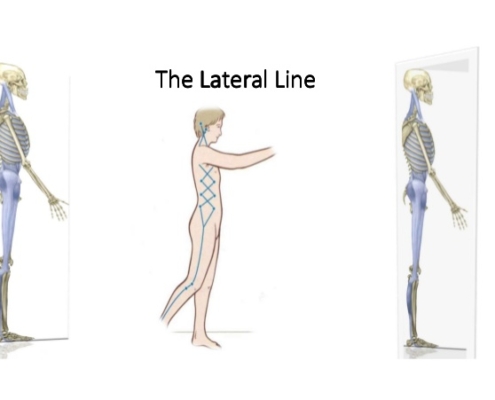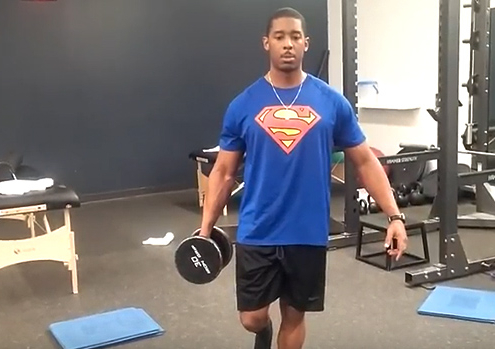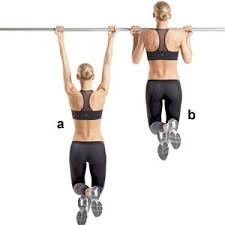Keeping Athlete Shoulders Healthy
With the initiation of a third lock down in the UK we thought it would be a great idea to engage our readers in some motivating posts to help keep you motivated. We welcome back APA coach Konrad McKenzie with a weekly guest post.
This lockdown 3.0 I have been fortunate to gain some more knowledge from leading practitioners in strength and conditioning & sport science. A couple of weeks ago I took part in a webinar with Chris McCleod and Ben Ashworth regarding shoulder health which I wanted to share with you. Those that know me will know I currently work in a Tennis Academy and have had previous work in Rugby and Swimming. So you can imagine this webinar was of interest to me.
Inherently, the shoulder joint is quite unstable, due to bony structures and lax ligaments most of its stability is provided by the rotator cuff musculature. It is particularly important to increase the structural strength of the local and global musculature around the joint. This blog will cover, what I learnt on the webinar with some of my own additions, the following topics will be:
- Local and global musculature of the shoulder
- Glenohumeral joint Stability
- Thoracic Mobility
- Volume load and Shoulder health
- Some exercises for your tool box
Local and Global muscles of the shoulder
As always, I wanted to introduce this topic by giving a brief overview of the anatomy of the shoulder. Frequently, when describing the anatomy of the body we use the terminologies “global” and “local”.
Local musculature
These are muscles located proximally to a joint and these muscles produce force to create stiffness around a joint during movement. Regarding the shoulder, local muscles include the supraspinatus, infraspinatus, subscapualris and teres minor. The aforementioned muscles form part of the rotator cuff complex and provide stability to the Glenohumeral joint during movement.
Global muscles
Global muscles are predominantly larger, superficial and responsible for initiating movement. These muscles attach from pelvis to rib cage and/or the upper extremities and are central to absorbing/transferring forces from upper and lower extremities to the pelvis. Global muscles in the shoulder girdle region include the Trapezius complex, Deltoids, Latissimus dorsi, Levator Scapulae and Rhomboids.
Detailing muscles in any part of the body is like peeling away layers of onion, so it is outside the scope of this blog to highlight every superficial and deep muscle tissue surrounding the shoulder.
The Scapula and Glenohumeral joint stability
The joint between the Humerus and the Scapular is known as the Glenohumeral joint. Typically injuries are sustained in the structures of the Glenohumeral joint. However, we must not dismiss the role of the scapular in maintaining healthy shoulder function. I particularly want to draw attention to the serratus anterior, which is interposed between the scapula and posterior Thorax. Studies have mentioned that the mobility of the serratus and subscapularis are vital for healthy shoulder function (Codman, 1934). Furthermore, the gliding, rotation & tilting of the Scapula is known as scapulathoracic gliding mechanisms. I would like to add that the scapula and subscapularis are not the only muscles of the scapula, muscles such as the upper trapezius, lower trapezius, Pectoralis minor work synergistically (force-couples) to position the scapula optimally.
Normal function of the Scapula is important. Shoulder strength can increase by up to 24% with appropriate scapular stabilization (Kibler, 2006).
Scapula Stability and Shoulder dysfunction
Sub-optimal scapula control due to over-activity in the upper trapezius and pectoralis minor is common. We know (particularly in overhead sports) that upward rotation of the scapula is imperative. Typically impairment is seen in a protracted and inferiorly positioned scapula. Additionally, the aforementioned dysfunction can decrease upward rotation thus decreasing sub-acromial space (Kilber, 2016).
Thoracic mobility (T-Spine)
I wanted to include this section because I believe, like the serratus anterior, T-spine mobility is important for healthy function. The thoracic spine is made up of twelve vertebrae (T1-12) in the middle segment of the vertebral column. In the Thorax the ribs articulate with each vertebra at the vertebral bodies and the transverse processes (Stull, 2016). Each thoracic vertebra rotates approximately 3°, therefore research has suggested that the thoracic spine should be able to produce 30-35° of rotation (Neumann, 2010). Now, you may be asking how this relates to shoulder function.
The thoracic spine is engineered in a way that it can move in all planes of movement (rotation, flexion/extension and lateral flexion). The NASM suggest that the thoracic spine can produce 20-25° of extension (While this is not true extension, due to natural curvature of the T-spine) it is pertinent to shoulder function.
So why is the small amount of extension in the upper back vital for shoulder movement?
Well, to move the arm into full shoulder flexion, this requires the T-spine to move into extension. During shoulder flexion the scapula rotates upwardly & posteriorly rotates on the rib cage. Now, it is said that if the T-spine lacks the ability to fully extend, the scapula is unable to posteriorly tilt as a result. If this is the case, the Glenohumeral joint is unable to get into full flexion then the risk of joint impingement increases.
Volume load and shoulder health
It is common knowledge within the sports performance world, that injury is multi-factorial. However, one powerful way to reduce risk is load management. Interestingly it was said in the webinar that training load spikes of > 60% significantly increases the chances of injury, loads of < 20% also incurred an injury risk outlining the need to neither overcook nor undercook athletes. Now, what’s even more interesting is that a robust shoulder girdle was more likely to withstand training spikes in between 20-60%. This highlighted the need to micro-dose athletes with shoulder strengthening work, especially when away in competition.
Some exercises for your toolbox
Now, I want to introduce you to some exercises you can use for your toolbox. Some of these exercises are nothing special when looking at them, but that’s what I liked about them. They are simple and effective but the intelligence comes from how and why we prescribe them. The webinar described the exercise selections as “Shapes”, which I found very useful. I will now share these with you.
Shape 1 – Single arm “Statue of liberty”
It was said that single arm work is best, around 120° relative to the trunk (angle slightly above head height). This reduces the potential pec dominance and increases serratus anterior activity when executing single arm exercises. With this in mind exercises, such as Landmine presses, single arm planks with arm slightly in front of the head make great exercises for shoulder stability.
Fig 1. Take a notice at the angle of the shoulder, relative to the trunk.
Benefits:
- Supports upward rotation and posterior tilt of the scapula, to open up space and offload the shoulder.
- With regard to tennis this exercise supports the avoidance of a shoulder dominant shot and “leading” with the shoulder.
Shape 2- “Y- shape”
This was said to target the connection between the posterior shoulder and mid-back. Additionally, on an EMG this shape was said to produce high activity in the posterior cuff and mid-back stabilisers. Furthermore, it was said that many people struggle to access this position. In my experience this is has been evident. A regression I have used is on the knees. This allows the athlete to feel the right positions. When doing this exercise it is advised to place the thumbs back to place the shoulder into external rotation and recruit the mid back musculature.
Benefits:
- Supports the overhead connection between the arm and body
- Protects against leaving the arm behind the body by connecting scapula to the Thorax
Shape 3- The lateral line
Muscles in the lateral line include the Obliques and unilateral trunk musculature. Exercises that target the lateral line include side planks, Single arm weighted carries and ipsilateral resistance training. Ben Ashworth suggested that athletes displaying a “buckling” of the hip during a single leg squat could be attributed with a weaker lateral line.
Benefits:
- Supports serve and overhead actions, which requires high amounts of side bend force, deceleration coupled with lateral hip stability.
- Provides a strong base to transfer force from the lower body into the arm and racket.
Shape 4- “Long Lat”
We need strong Lats for a healthy shoulder (Think about its origins and insertions). But, we also need Lats that can produce force through a full range of motion. In overhead sports, this is important due to the racket and arm over the shoulder without any force leakage.
Benefits:
- Optimising efficient mechanics
- Producing and maintaining force with a long lever arm.
This was a great webinar, I certainly learnt lots whilst supporting my own knowledge already. I hope this blog has been insightful and causes you to do some of your own research around the shoulder. Thanks to Ben Ashworth and Chris McCleod for their outstanding work!
Thanks for reading guys,
Konrad McKenzie
Strength and Conditioning coach.
Liked This Blog?
You might like other blogs on this topic from APA:
APA review of the Middlesex Students S&C conference 2014
The Dubious Rise of the Corrective Exercise ”Pseudo-Physio” Posing as a Trainer- My thoughts
as well as two recommended articles:
This article on weak Glutes during Squatting
And this one on Exercise Modifications
Do you feel that this would be a perfect time to work on the weak links that you have been avoiding? The things that you know you should be doing that you keep putting off? Would you like us to help you with movement screening and an injury prevention program? Then click on the link below and let us help you!
? TRAIN WITH APA ?
Aspiring Pro Training Support Packages
Follow me on instagram @konrad_mcken
Follow Daz on instagram @apacoachdaz
- If you’re not subscribed yet, click here to get free email updates, so we can stay in touch.
- Share this post using the buttons on the top and bottom of the post. As one of this blog’s first readers, I’m not just hoping you’ll tell your friends about it. I’m counting on it.
- Leave a comment, telling me where you’re struggling and how I can help
Since you’re here…
…we have a small favor to ask. APA aim to bring you compelling content from the world of sports science and coaching. We are devoted to making athletes fitter, faster and stronger so they can excel in sport. Please take a moment to share the articles on social media, engage the authors with questions and comments below, and link to articles when appropriate if you have a blog or participate on forums of related topics. — APA TEAM




